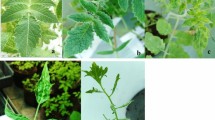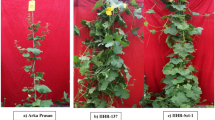Abstract
The whitefly-transmitted Tomato chlorosis virus (ToCV) (genus Crinivirus) is associated with yield and quality losses in field and greenhouse-grown tomatoes (Solanum lycopersicum) in South America. Therefore, the search for sources of ToCV resistance/tolerance is a major breeding priority for this region. A germplasm of 33 Solanum (Lycopersicon) accessions (comprising cultivated and wild species) was evaluated for ToCV reaction in multi-year assays conducted under natural and experimental whitefly vector exposure in Uruguay and Brazil. Reaction to ToCV was assessed employing a symptom severity scale and systemic virus infection was evaluated via RT-PCR and/or molecular hybridization assays. A subgroup of accessions was also evaluated for whitefly reaction in two free-choice bioassays carried out in Uruguay (with Trialeurodes vaporariorum) and Brazil (with Bemisia tabaci Middle-East-Asia-Minor1—MEAM1 = biotype B). The most stable sources of ToCV tolerance were identified in Solanum habrochaites PI 127827 (mild symptoms and low viral titers) and S. lycopersicum ‘LT05’ (mild symptoms but with high viral titers). These two accessions were efficiently colonized by both whitefly species, thus excluding the potential involvement of vector-resistance mechanisms. Other promising breeding sources were Solanum peruvianum (sensu lato) ‘CGO 6711’ (mild symptoms and low virus titers), Solanum chilense LA1967 (mild symptoms, but with high levels of B. tabaci MEAM1 oviposition) and Solanum pennellii LA0716 (intermediate symptoms and low level of B. tabaci MEAM1 oviposition). Additional studies are necessary to elucidate the genetic basis of the tolerance/resistance identified in this set of Solanum (Lycopersicon) accessions.


Similar content being viewed by others
References
Akhtar MS, Goldschmidt EE, John I, Rodoni S, Matile P, Grierson D (1999) Altered patterns of senescence and ripening in gf, a stay-green mutant of tomato (Lycopersicon esculentum Mill.). J Exp Bot 50:1115–1122
Arruabarrena A, Rubio L, González-Arcos M, Maeso D, Fonseca MEN, Boiteux LS (2014) First report of Tomato chlorosis virus infecting tomato crops in Uruguay. Plant Dis 98:1445
Arruabarrena A, Rubio L, González-Arcos M, Maeso D, Sánchez-Campos S, Fonseca MEN, Boiteux LS (2015) First report of Solanum sisymbriifolium and S. americanum as natural weed hosts of Tomato chlorosis virus (genus Crinivirus) in South America. Plant Dis 99:895
Barbosa JC, Costa H, Gioria R, Rezende JA (2011) Occurrence of Tomato chlorosis virus in tomato crops in five Brazilian states. Trop Plant Pathol 36:256–258
Blawid R, Morgado FS, Souza CA, Resende RO, Boiteux LS, Pereira-Carvalho RC (2015) Fluorescence in situ hybridization analysis of endosymbiont genera reveals novel infection patterns in a tomato-infesting Bemisia tabaci population from Brazil. Trop Plant Pathol 40:233–243
Boiteux LS, Oliveira VR, Silva CH, Makishima N, Inoue-Nagata AK, Fonseca MEN, Giordano LB (2007) Reaction of tomato hybrids carrying the Ty-1 locus to Brazilian bipartite Begomovirus species. Hortic Bras 25:20–23
Boiteux LS, Fonseca MEN, Reis A, Costa AF, Fontes MG, González-Arcos M (2016) Wild radish (Raphanus spp.) and garden rocket (Eruca sativa) as new Brassicaceae hosts of Tomato chlorosis virus in South America. Plant Dis 100:1027
Boiteux LS, Lima MF, Fonseca MEN, Mendonça JL, Costa AF, Silva-Filho JG, Fontes MG, González-Arcos M (2018) Identification of eight Solanum (subgenus Leptostemonum) species as novel natural hosts of Tomato chlorosis virus in Brazil. Plant Dis 102:1673
Conover WJ (1998) Practical nonparametric statistics, 3rd edn. Wiley, New York
Cooper JI, Jones AT (1983) Responses of plants to viruses: proposal for the use of terms. Phytopathology 73:127–128
Dovas CI, Katias NI, Avgelis AD (2002) Multiplex detection of criniviruses associated with epidemics of yellowing disease of tomato in Greece. Plant Dis 86:1345–1349
Escobar-Bravo R, Alba JM, Pons C, Granell A, Kant MR, Moriones E, Fernández-Muñoz R (2016) A jasmonate-inducible defense trait transferred from wild into cultivated tomato establishes increased whitefly resistance and reduced viral disease incidence. Front Plant Sci 7:1732
Fernández-Muñoz R, Salinas M, Alvarez M, Cuartero J (2003) Inheritance of resistance to two-spotted spider mite and glandular leaf trichomes in wild tomato Lycopersicon pimpinellifolium (Jusl.) Mill. J Am Soc Hortic Sci 128:188–195
Fonseca MEN, Boiteux LS, Abreu H, Nogueira I, Pereira-Carvalho RC (2013) Physalis angulata: a new natural host of Tomato chlorosis virus in Brazil. Plant Dis 97:692
Fonseca MEN, Boiteux LS, Lima MF, Mendonça JL, Costa AF, Fontes MG, Costa H, González-Arcos M (2016) First report of Tomato chlorosis virus infecting eggplant and scarlet eggplant in Brazil. Plant Dis 100:867
Fortes IM, Moriones E, Navas-Castillo J (2012) Tomato chlorosis virus in pepper: prevalence in commercial crops in southeastern Spain and symptomatology under experimental conditions. Plant Pathol 61:994–1001
García-Cano E, Resende RO, Fernández-Muñoz R, Moriones E (2006) Synergistic interaction between Tomato chlorosis virus and Tomato spotted wilt virus results in breakdown of resistance in tomato. Phytopathology 96:1263–1269
García-Cano E, Navas-Castillo J, Moriones E, Fernández-Muñoz R (2010) Resistance to Tomato chlorosis virus in wild tomato species that impair virus accumulation and disease symptom expression. Phytopathology 100:582–592
Giordano LB, Silva-Lobo VL, Santana FM, Fonseca MEN, Boiteux LS (2005) Inheritance of resistance to the bipartite Tomato chlorotic mottle begomovirus derived from Lycopersicon esculentum cv. ‘Tyking’. Euphytica 143:27–33
Hanssen IM, Lapidot M, Thomma BPHJ (2010) Emerging viral diseases of tomato crops. Mol Plant Microbe Interact 23:539–548
Holm S (1979) A simple sequentially rejective multiple test procedure. Scand J Stat 6:65–70
Kerr EA (1956) Green flesh, gf. In: Report of tomato genetics cooperative, vol 6, p 17
Kerr EA (1958) Linkage relations of gf. Tomato Genet Coop Rep 8:21
Macedo MA, Barreto SS, Hallwass M, Inoue-Nagata AK (2014) High incidence of Tomato chlorosis virus alone and in mixed infection with begomoviruses in two tomato fields in the Federal District and Goiás State, Brazil. Trop Plant Pathol 39:449–452
Mansilla-Córdova PJ, Bampi D, Rondinel-Mendoza NV, Melo PCT, Lourenção AL, Rezende JAM (2018) Screening tomato genotypes for resistance and tolerance to Tomato chlorosis virus. Plant Pathol 67:1231–1237
Menezes-Jr AO, Mikami AY, Ide AK, Ventura MU (2005) Feeding preferences of Microtheca punctigera (Achard) (Coleoptera: chrysomelidae) for some Brassicaceae plants in multiple-choice assays. Sci Agric 62:72–75
Mongkolsiriwattana C, Zhou JS, Ng JC (2016) A 3-end structure in RNA2 of a crinivirus is essential for viral RNA synthesis and contributes to replication-associated translation activity. Sci Rep 6:34482
Mutschler MA, Wintermantel WM (2006) Reducing virus associated crop loss through resistance to insect vectors. In: Loebenstein G, Carr JP (eds) Natural resistance mechanisms of plants to viruses. Springer, New York, pp 241–260
Navas-Castillo J, Camero R, Bueno M, Moriones E (2000) Severe outbreaks in tomato in Spain associated with infections of Tomato chlorosis virus. Plant Dis 84:835–837
Navas-Castillo J, Fiallo-Olivé E, Sánchez-Campos S (2011) Emerging virus diseases transmitted by whiteflies. Ann Rev Phytopathol 49:219–248
Navas-Castillo J, López-Moya JJ, Aranda MA (2014) Whitefly-transmitted RNA viruses that affect intensive vegetable production. Ann Appl Biol 165:155–171
Orfanidou CG, Pappi PG, Efthimiou KE, Katis NI, Maliogka VI (2016) Transmission of Tomato chlorosis virus (ToCV) by Bemisia tabaci biotype Q and evaluation of four weed species as viral sources. Plant Dis 100:2043–2049
Pereira-Carvalho RC, Díaz-Pendón JA, Fonseca MEN, Boiteux LS, Fernández-Muñoz R, Moriones E, Resende RO (2015) Recessive resistance derived from tomato cv. Tyking limits drastically the spread of tomato yellow leaf curl virus. Viruses 7:2518–2533
Rakha M, Hanson P, Ramasamy S (2017) Identification of resistance to Bemisia tabaci Genn. in closely related wild relatives of cultivated tomato based on trichome type analysis and choice and no-choice assays. Genet Resour Crop Evol 64:247–260
Rodriguez-Lopez MJ, Garzo E, Bonani JP, Fereres A, Fernández-Muñoz R, Moriones E (2011) Whitefly resistance traits derived from the wild tomato Solanum pimpinellifolium affect the preference and feeding behavior of Bemisia tabaci and reduce the spread of Tomato yellow leaf curl virus. Phytopathology 101:1191–1201
Rodriguez-Lopez MJ, Garzo E, Bonani JP, Fernández-Muñoz R, Moriones E, Fereres A (2012) Acylsucrose-producing tomato plants forces Bemisia tabaci to shift its preferred settling and feeding site. PLoS ONE 7:e33064
Shi X, Tang X, Zhang X, Zhang D, Li F, Yan F, Zhang Y, Zhou X, Liu Y (2018) Transmission efficiency, preference and behavior of Bemisia tabaci MEAM1 and MED under the influence of Tomato chlorosis virus. Front Plant Sci 8:2271
Silva KFAS, Michereff-Filho M, Fonseca MEN, Silva-Filho JG, Texeira ACA, Moita AW, Torres JB, Fernández-Muñoz R, Boiteux LS (2014) Resistance to Bemisia tabaci biotype B of Solanum pimpinellifolium is associated with higher densities of type IV glandular trichomes and acylsugar accumulation. Entomol Exp Appl 151:218–230
Tzanetakis I, Martin R, Wintermantel W (2013) Epidemiology of criniviruses: an emerging problem in world agriculture. Front Microbiol 4:119
Wintermantel WM, Wisler GC (2006) Vector specificity, host range, and genetic diversity of Tomato chlorosis virus. Plant Dis 90:814–819
Wintermantel WM, Cortez AA, Anchieta AG, Gulati-Sakhuja A, Hladky LL (2008) Co-infection by two criniviruses alters accumulation of each virus in a host-specific manner and influences efficiency of virus transmission. Phytopathology 98:1340–1345
Wisler GC, Duffus JE (2001) Transmission properties of whitefly-borne criniviruses and their impact on virus epidemiology. In: Harris KF, Smith OP, Duffus JE (eds) Virus–insect–plant interactions. Academic Press, San Diego, pp 293–308
Wisler GC, Li RH, Liu H-Y, Lowry DS, Duffus JE (1998) Tomato chlorosis virus: a new whitefly-transmitted, phloem-limited, bipartite closterovirus of tomato. Phytopathology 88:402–409
Zar JH (1984) Biostatistical analysis, 2nd edn. Prentice Hall-Englewood Cliffs, New Jersey
Acknowledgements
This work was done in the context of MG-A doctoral studies program, Facultad de Agronomía, Universidad de la República Oriental del Uruguay. We thank A. Manzzioni, M. Giambiasi, A. Britos and L. Rubio of INIA Salto Grande, and W. Pereira and A. Costa of Embrapa Hortaliças, for their assistance in conducting some of the experiments. LSB and MENF were supported by CNPq grants. EM was supported by Grant AGL2016-75819-C2-2 and RF-M was supported by Grant AGL2015-65246-R, funded by the Ministerio de Economía y Competitividad, Spain, with assistance from the European Regional Development Fund (ERDF) and the European Social Fund (ESF).
Author information
Authors and Affiliations
Corresponding author
Electronic supplementary material
Below is the link to the electronic supplementary material.
Rights and permissions
About this article
Cite this article
González-Arcos, M., de Noronha Fonseca, M.E., Arruabarrena, A. et al. Identification of genetic sources with attenuated Tomato chlorosis virus-induced symptoms in Solanum (section Lycopersicon) germplasm. Euphytica 214, 178 (2018). https://doi.org/10.1007/s10681-018-2253-9
Received:
Accepted:
Published:
DOI: https://doi.org/10.1007/s10681-018-2253-9




